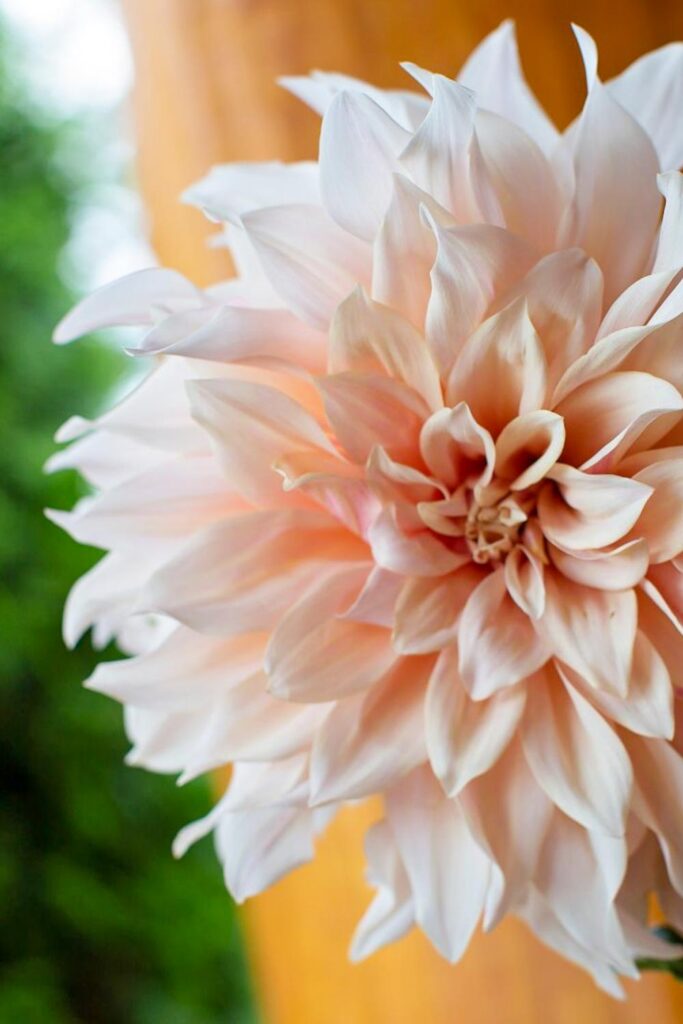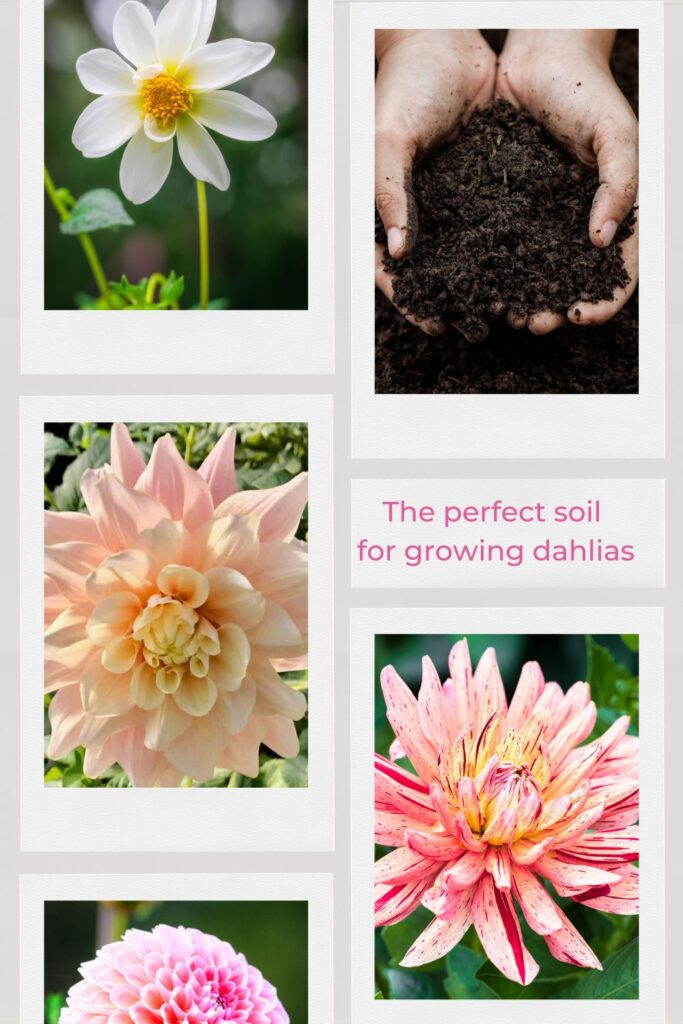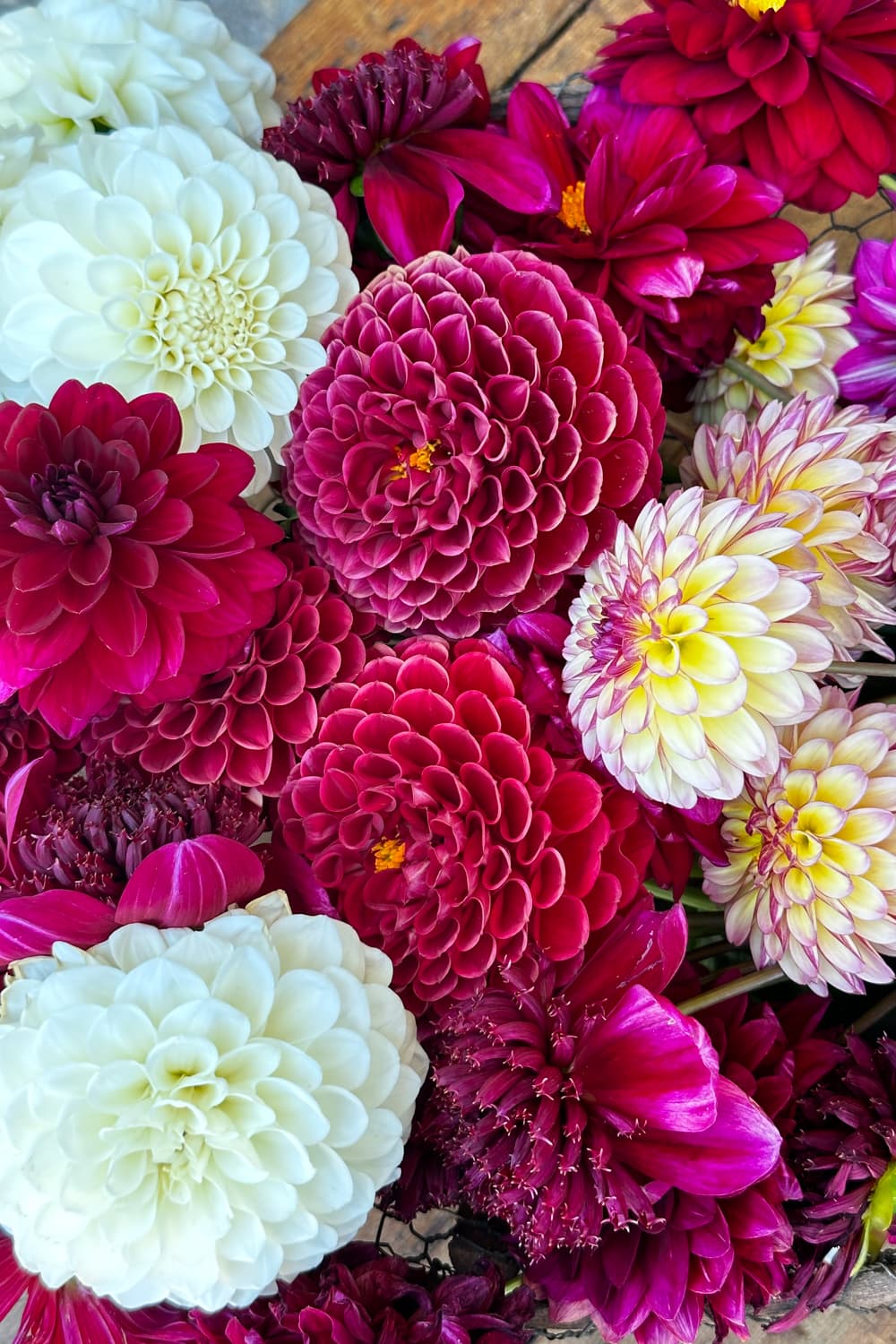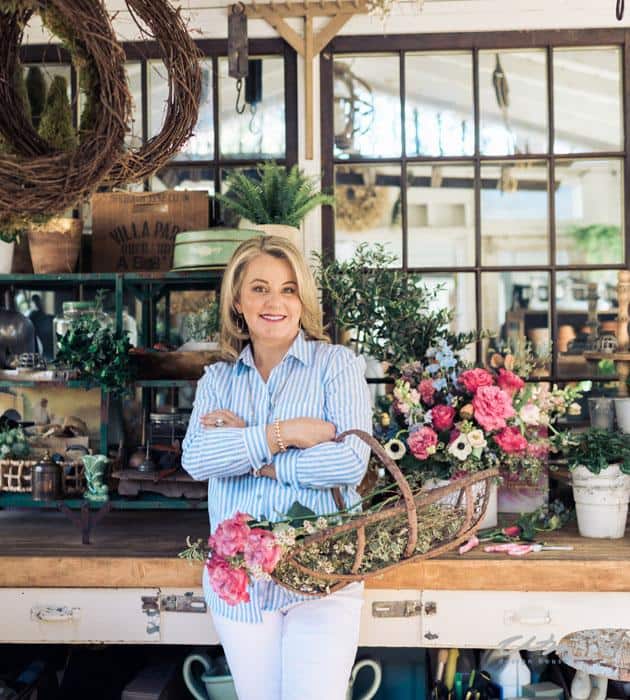The Best Soil for Dahlias; How to Grow Beautiful Flowers
Discover the best soil for dahlias and how to care for them to ensure your favorite flowers flourish.
As gardening season approaches, the excitement of planting can be overwhelming.
However, it’s crucial not to overlook the essential step of creating a solid foundation for your plants to thrive.
While it may not be the most glamorous task, taking the time to establish a healthy planting base will pay off in the long run.
Trust me; you’ll thank yourself later. So, let’s ensure your garden’s success by starting with a strong foundation.
Dahlias can be grown as annuals in zones 2-7 and as a perennial in zones 8-11.

Soil Essentials for Dahlias

A beautiful garden begins with healthy soil, as the soil quality determines the quality of the plants grown.
Restoring the nutrients lost over the winter months is essential to ensure good plant growth with the onset of the new growing season.
Unfortunately, the winter months take a toll on the garden, and we must replenish the nutrients before planting.
Providing the soil with the necessary nutrients can promote strong growth, season after season. Remember – healthy soil equals healthy plants!
As a knowledgeable gardener, you know that soil fertility is essential for optimal plant growth and nutrient absorption.
Well-drained soil with plenty of peat moss and organic matter is key regarding dahlias.
Soil not only produces nutrients for our plants, but it also is the anchor that holds our plants in place as they grow.

What is the Best Soil for Dahlia Plants
Dahlias are known for their resilience thanks to their unique tubers that store crucial nutrients during the dormant season.


These small tubers sit safely below the ground, preparing the plant for the upcoming year’s challenges.
However, these tubers are easily susceptible to rotting, especially in the early days of growth before roots take hold. Proper care and attention are essential to ensure the dahlias thrive year after year.
If you want to grow healthy and vibrant dahlias, it’s crucial to have optimal soil conditions. Lightweight, well-draining soil is essential for these plants to thrive.
That is why clay soil is not suitable for dahlias as it retains too much moisture. This can lead to insufficient oxygen reaching the roots and cause damage to the plant.
Understanding how soil pH affects plant growth can ensure your dahlias thrive in their ideal environment.
To achieve optimal growth for dahlias, it’s important to maintain a soil pH of approximately 6.3 to 6.8, according to the American Dahlia Society. This range indicates a slightly acidic soil, which is what dahlias prefer.
Soils typically fall between a pH range of 6 to 8, with six being more acidic and eight being more alkaline. Acidic soils can often be found in areas with trees that shed needles annually, contributing to a lower pH level.
Dahlias also like low Nitrogen and high phosphorus nutrients in their soil.
On my blog WM Design House, I may sometimes use affiliate links, which means a small commission is earned if you make a purchase via the link. The price will be the same whether you use the affiliate link or go directly to the vendor’s website using a non-affiliate link.
How to Create the Best Soil for Dahlias

Don’t let soil type keep you from growing dahlias! Dahlias need three basic things to grow well.
Good Nutrient Soil
Sandy soil needs a helping hand in the form of homemade compost, decayed leaf matter, and cow or steer manure (organic material ). Mix it well into the soil.
Clay soil requires drainage amendments as well as added nutrients. Add peat moss and sand to lighten the soil so your dahlia garden can flourish.
I also highly recommend testing your soil once you have amended it to be sure you have the proper nutrients for growing dahlia flowers. You can purchase a soil test kit to check the ph, nitrogen, phosphorus, and more. By using a test kit, you will know exactly what you need to add to your soil.
A low-nitrogen fertilizer is best when nurturing flowering plants from which you want blooms. Look for labels such as 5-10-10 or 3–12–12: the first number being lower than the other two, to achieve this effect.
Phosphorus is also particularly beneficial; high quantities in your garden soil can produce beautiful blossoms year-round!
Bone Meal is another good idea, as it is a great source of phosphorus and will aid in root growth.
Remember, dahlias do not like too much nitrogen and love fertile soil.
Warm Soil and Sunny Days

Dahlia tubers do not like cold soil. Wait until the last frost has passed and the soil temperature reaches 60 degrees for the best results.
You can use a basic meat thermometer to test the temperature of your soil.

Well Draining Soil
As we have talked about previously, you shouldn’t have a heavy soil. Be sure to prep your soil properly before planting your tuberous roots. I also like to add Perlite to my soil to aid in drainage.
Best Soil for Potted Dahlias
Dahlias, are perfect for potted containers.
I like to use Happy Frog planting soil. It is an amazing organic potting soil that will help you to grow beautiful flowers. This soil is always my number one choice.

If that is not available, you can use Miracle Grow potting mix, which is also a great option.
In addition, I like to add Perlite or Vermiculite to help ensure good drainage. And why not add some nutrient-rich compost into the mix while you’re at it? With proper care, your dahlia container garden will bloom all season long!
Dahlia Varieties for Cut Flowers
Dahlias come in a multitude of varieties, with over 57,000 species recognized.
And where did dahlias come from? Mexico and Central America according to Sarah from SCCflowerfarm. Stop by to read her wonderful blog and the story of dahlias and where they come from.
Here are a few of my favorite varieties. It is so hard to choose as there are so many different varieties.
Single Dahlias
A flower that has a middle disk surrounded by single petals.

Orchid Dahlia
Orchid dahlias are among the most exotic of all varieties – varying from single to double. Single orchids will show off their singular row of petals, while doubles layer two rows on top that almost seem to conceal their center.
Orchid Dahlias

Sunset Mix

Orchid Princess

Hot Pink Orchid
Dinner Plate Dahlias
Dinner plate dahlias are show-stopping blooms that boast spectacularly large flowers – some with petals up to ten inches wide. An eye-catching addition to any garden, these gorgeous dahlias will take your breath away!
Pom POm Dahlias

Cafe Au Lait

Dahlia Fleurel

Breakout
Pom Pom Dahlias
With their delicate petals and round shape, Pom Pom Dahlias offer a smaller bloom than the larger Ball Dahlia – but no less of an impact!
These charming flowers stand out with their tight formation, measuring only two inches across.
Pom POm Dahlias

Jowey Martina

Boom Boom

Little Peaches
Where to buy your Dahlia Tubers
I purchase my Dahlia tubers and seeds from SCCFlowerfarm. I love to support Sarah and her family-run farm in the countryside of Stillwater, Minnesota. Sarah and her family have been growing dahlias, tulips, peonies and more since 2017. You will love everything about them, I promise.

Where to Plant Dahlia Tubers
Choose your location

Dahlias love full sun and lots of morning sunlight.
Afternoon shade is also fine, but ensure they have at least 6-8 hours of direct sunlight.
I prefer to plant in raised beds as I can easily control the soil conditions. In addition, I can place my raised beds in the perfect place to ensure that my dahlias get enough sunlight.

Planting Tips for Dahlias
Planting dahlia tubers is rather easy. Follow my tips below, and do NOT water until they have sprouted.
- The best time to plant tubers is after the last frost date has passed, and there is no more danger of frost. Since tubers store water and nutrients, they will freeze and not return if the ground is too cold.
- Test your soil and be sure it is 60 degrees or warmer.
- You can always start the tubers in pots indoors if you live in a cold climate. Next, be sure to harden them off before transplanting them outside.
- You want to plant your dahlias 12-15″ apart.
- Dig a hole approximately 4″ deep.
- Place the tuber in the hole with the eye facing up.
- Cover the tuber with 2-3 inches of dirt.
- As the stems sprout, you can fill in with more dirt.
- Do not place mulch around the tuber.
- Place a stick or stake in the ground when planting, as the plants will need support as they grow. By doing this at the time of planting, you are sure not to disturb the tubers.
Growing Tips for Dahlias
Once your dahlias become young plants, you must take good care of them. Here is a list of my tips to help you have beautiful blooms all summer long.

Watering
Watering is very specific to the zone you live in.
I live in zone 10a, so I water my dahlias every other day in the spring and every day in the summer.
- Regular watering is ideal. This is better than a lot of water less often.
- Water plants in the early morning.
- Do not let the soil dry out and get clay-like.
- Dahlias like moist soil
- If you can, use a drip irrigation system
- Water at the base of the plant, do not water the foliage and blossoms
Fertilizing
Dahlias are heavy feeders and love to be fertilized. There are three different ideas about how to fertilize dahlias.
- You can use an all-purpose plant food like miracle grow and place it in a circle around the base once the plants are sprouted.
- Use a low-nitrogen fertilizer once a month during the growing season.
- Amend your soil before planting to ensure it has the appropriate nutrients.
- Worm castings are an invaluable organic fertilizer, boasting beneficial microbes that can drastically improve your soil’s biology and health. With regular use throughout the growing season, they add vital nourishment to the earth while encouraging a thriving environment for plant growth.
I amend my soil with peat moss, sand and worm castings. Next, I add bone meal once they have sprouted. Then I will fertilize them once a month during the growing season.
Pinching Back New Growth
This is an essential part of growing beautiful dahlias. Pinching back the new growth once you have three sets of leaves will ensure a bushier plant and more flower production.
This is a simple process. You can use your finger or a sharp knife to remove the new growth once the plant is about 8″ tall and has at least three sets of leaves.
You can see in this images where I have pinched off the center of the plant and how the new growth is coming in around the center.


See my video here of how to pinch back a dahlia
Deadheading Your Dahlias
You can extend the plant’s longevity by deadheading your plants.
Deadheading is the term used to cut off the flowers of a plant that are dying or have already died.
The more flowers you cut, the more flowers you will get.
Deadheading promotes more growth, makes the plant look better, and encourages continued blooming.
Staking Your Dahlias
Most, but not all, dahlias are tall plants and need support as they grow.

I prefer to place the stake in the ground when you plant the tubers so it does not disturb the plant’s root system or tubers.
Use a wood or metal stake approximately six feet tall by 1.5″ diameter. You can also use a tomato cage.
As your plant grows, you’ll want to tie its main stems safely onto this anchor point with twine,
Make sure there’s some slack though, so it has room to move in case you get strong winds.
Harvesting your Dahlias for the winter
If you live in zones 2-7, you will need to dig up your tubers and store them in a cool, dry place until the following year when they wake up and you can plant them again.

This is what you need to do to harvest your tubers.
- Prune the plant down to a few inches.
- Carefully dig around with a shovel to unearth the plant roots.
- Shake the dirt off and cover it with sawdust or wood chips. Another option is to wrap each tuber in plastic wrap.
- You want to keep them in a cool place so they remain dormant. Fifty degrees is ideal.
- Once they warm up, the dahlia eyes start to sprout, which is when you will plant them again.
- Keep them away from a lot of moisture so they do not rot.
Propagating your Dahlias
There are several ways to propagate your dahlias.
Propagating dahlias from tubers
- Gather your over-wintered tubers, some planting soil, peat moss, and Perlite.
- Carefully blend the soil, peat moss and Perlite in a bucket, giving it enough water to moisten. This mixture is then transplanted into your growing containers – ensuring that tubers have all they need as their root system develops and sprouts come forth!
- To identify which tubers are ready to be planted, closely examine your clump and locate the eyes. If you do not see any eyes, place them in warm moist conditions for several days until you can spot signs of sprouting – then carefully cut them off from their necks with sharp sheers or a knife. Depending on how many tubers are within each clump, you may remove multiple ones when preparing for planting.
- Place some soil in your pots, dig a hole, and lay the tuber in the hole on its side with the eye of the tuber facing up. Cover the tuber with 1-2″ of dirt.
- Once the tuber sprouts, you can start to water the plant.
- Once the plant has at least three layers of leaves, pinch off the center.
- Transplant outdoors once the ground is 60 degrees.
Propagating dahlias from cuttings
I have never done this myself, but I will try it this year.
I found a fabulous article with very detailed instructions from gardenerspath.com. You will find everything you need to know in this article about propagating from cuttings.
Propagating dahlias from seed
- You can purchase seeds at your local nursery and plant the seeds
- Harvest your seeds
- When the flower heads dry out and take on a yellowish-tan color, it’s time to snip them off and delicately separate the petals.
- Collect your seeds in a paper bag, a small Tupperware container, or an envelope.
- Transfer them to somewhere cool and shady for storage until you’re ready to sow next season.
Pest Control for Dahlias
Like any other plant in the garden, dahlias are susceptible to pests and disease.
Some common pests you may find on your dahlias are:
- Slugs
- Snails
- Earwigs
- Tarnished plant bugs
- Thrips
- Potato leafhoppers
- Spider mites
- Leaf miners


I highly suggest using an organic pest control or spray to keep these pests at bay.
I like to use Captain Jack’s Deadbug, this product cures the problem very quickly.
This image above is a bug called a leaf miner. The insect is actually inside of the leaf and mines trails in the leaves. If you catch this early and spray, it should solve the problem.
Some of the common diseases of dahlias are :
- Powdery mildew
- Grey mold
- Verticillium Wilt
- Bacterial diseases
- Leafy Gall
You can read more from this article from the American Dahlia Society
Well, I think I have covered almost everything you need to know about growing dahlias. However, I cannot stress enough how important it is to have the proper soil to start your dahlia plants. I hope you enjoyed this post and learned something new.
Happy Planting!























Dinner Plate Dahlias are my favorite variety. I wish I could grow them. I have tried many things, right now, I have a few succulents that are growing. Ha! That is my contribution to gardening, and the only thing I have been able to grow. My hydrangeas have only bloomed once in 10 years. I cannot figure it out so I just shrug my shoulders and hope I do something right again soon so they bloom again. Thank you for sharing Wendy!
Oh, Cara, I will have to send you a few. Gardening can be finicky. So many things have to be just right. Give your hydrangea some Epsom salts. They make like that.
Amazing, although I do not garden anymore, now it’s over to our daughter and SIL, but I will share this with them. Love those pom pom dalias.
I visited you via Crafty Creators Link Party
If you are not already part of SSPS, this is a personal invite to hop over and come and share your own awesome posts with us at Senior Salon Pit Stop, every Monday to Saturday, and share your awesome post/s with us as well.
If interested, find my entries: 28-29 and then navigate toward the bottom of my page for the Senior Salon Pit Stop linkup, we hope to meet you there virtually.
Thank you from your SSPS Vroom Vroom Team for sharing your links with us. Please check back Monday to see if featured on the blog post or by any of the co-hosts.
So much good information Wendy. I’ve never tried growing Dahlia’s but you have me thinking I should.
Oh, Susan, you would love them! They are the most beautiful flowers that bloom all summer long.
Wendy, this is amazing! You should make an e-book out of this post. There is so much wonderful information in this post! I have no luck with dahlias, or should I say that I was having great luck before the deer came and ate them all so I gave up. I might have to try pots next year.
Have a wonderful day!
Thank you, Elizabeth, that is a fabulous idea. As pretty as they are, those darn deer can be a problem. Thank you for your sweet comment.